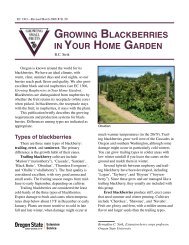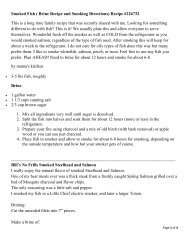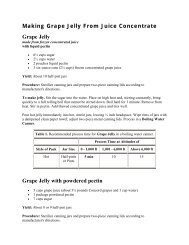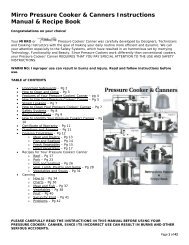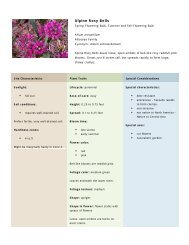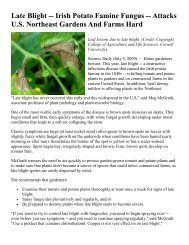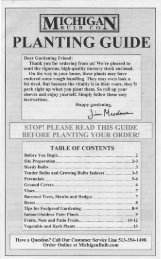Strawberry and Raspberry Pest Management in Wisconsin
Strawberry and Raspberry Pest Management in Wisconsin
Strawberry and Raspberry Pest Management in Wisconsin
You also want an ePaper? Increase the reach of your titles
YUMPU automatically turns print PDFs into web optimized ePapers that Google loves.
<strong>Raspberry</strong> Weed <strong>Management</strong><br />
Effective weed management <strong>in</strong> raspberries comb<strong>in</strong>es cultivation,<br />
mulches, <strong>and</strong> herbicides. Weed management is essential to reduce<br />
competition for water, nutrients, <strong>and</strong> light dur<strong>in</strong>g the development of<br />
the crop. Weeds can also harbor diseases <strong>and</strong> <strong>in</strong>sect pests <strong>and</strong> can<br />
<strong>in</strong>terfere with cultural practices <strong>and</strong> harvest<strong>in</strong>g.<br />
Elim<strong>in</strong>ate perennial weeds such as quackgrass, thistles, <strong>and</strong> dock the<br />
year before plant<strong>in</strong>g by us<strong>in</strong>g smother crops; summer fallow; nonresidual,<br />
systemic herbicides; <strong>and</strong> cultivated agronomic row crops.<br />
Not all weeds that occur <strong>in</strong> raspberry plant<strong>in</strong>gs <strong>in</strong> Wiscons<strong>in</strong> are<br />
controllable with herbicides. Additionally, repeated use of the same<br />
herbicide on the same field grow<strong>in</strong>g the same crop may lead to weed<br />
resistance. In these cases mechanical means such as cultivation, pull<strong>in</strong>g,<br />
<strong>and</strong> h<strong>and</strong> hoe<strong>in</strong>g are necessary. Mulches can also control annual<br />
weeds. Both organic mulches, such as straw, leaves, sawdust, or wood<br />
chips, <strong>and</strong> synthetic mulches, such as polyethylene, m<strong>in</strong>imize weed<br />
problems <strong>and</strong> conserve soil moisture. Young raspberry fields<br />
established with organic mulches typically produce significantly more<br />
canes than unmulched fields. After the establishment year, mulches<br />
may be less beneficial for plants due to rodent problems, higher<br />
disease <strong>in</strong>cidence, <strong>and</strong> shallow root<strong>in</strong>g.<br />
You can control weed growth between the rows by plant<strong>in</strong>g sod such<br />
as Kentucky bluegrass, perennial rye, or red fescue at the time of<br />
plant<strong>in</strong>g. Sod prevents many weeds from grow<strong>in</strong>g, <strong>and</strong> occasional<br />
mow<strong>in</strong>g slows the growth of other weeds. It also reduces dust <strong>and</strong> soil<br />
compaction, improves field access after ra<strong>in</strong> or irrigation, <strong>and</strong>. helps<br />
ma<strong>in</strong>ta<strong>in</strong> soil structure <strong>and</strong> organic matter levels.<br />
After plant<strong>in</strong>g, shallow cultivation <strong>in</strong> the plant rows can help reduce<br />
weed problems. Cultivation also serves to keep the rows narrow <strong>and</strong> to<br />
elim<strong>in</strong>ate excess canes. To reduce the potential for root damage, don’t<br />
cultivate deeper than 2–3 <strong>in</strong>ches. In established plant<strong>in</strong>gs, cultivation<br />
should stop before harvest to avoid knock<strong>in</strong>g fruit off the canes.<br />
HERBICIDE USE Chemical weed control <strong>in</strong> established plant<strong>in</strong>gs is of most value <strong>in</strong><br />
reduc<strong>in</strong>g weed populations <strong>in</strong> the plant<strong>in</strong>g row. Growers us<strong>in</strong>g an<br />
herbicide for the first time should limit the treated area until they are<br />
familiar with the herbicide’s effectiveness <strong>and</strong> crop safety. Sprayers<br />
should be calibrated at least each year.<br />
Young tissue-cultured plants are much more susceptible to herbicide<br />
damage than traditional dormant cane stock. Ideally, avoid us<strong>in</strong>g<br />
herbicides on these plants before fall of the establishment year or use<br />
the lowest labeled rates on new plants.<br />
If you are apply<strong>in</strong>g herbicides only to the plant<strong>in</strong>g row, be sure to<br />
calculate the actual area be<strong>in</strong>g sprayed <strong>and</strong> not the entire plant<strong>in</strong>g<br />
area. Otherwise you will overapply, lead<strong>in</strong>g to plant <strong>in</strong>jury or death.<br />
Before us<strong>in</strong>g a herbicide, read <strong>and</strong> follow the label directions! Use only<br />
registered materials. Table 10 lists herbicides registered for use on<br />
raspberries <strong>in</strong> Wiscons<strong>in</strong>. Products are listed alphabetically <strong>and</strong><br />
represent treatment options for each period covered. Inclusion of<br />
product names is not an endorsement of a manufacturer’s br<strong>and</strong>.<br />
39




